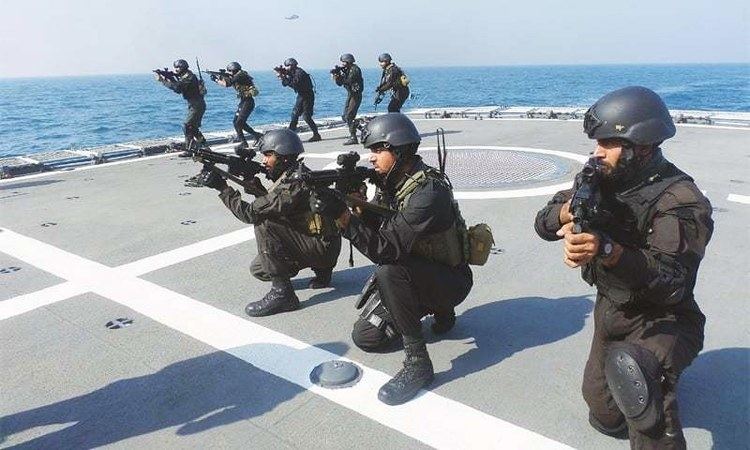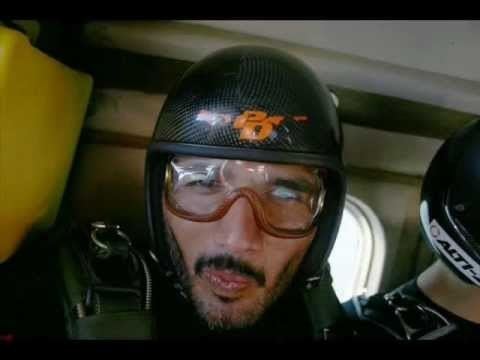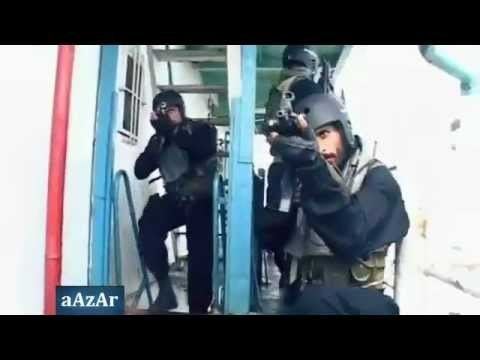Active 1966 - Present Branch Pakistan Navy Headquarters Cherat, Pakistan | Country Pakistan Size Classified | |
Type Special Operations Force Role Primary tasks:
Direct Action
Counter/Anti Terrorism
Other roles:
Foreign internal defense
Unconventional warfare
Security assistance
Special Reconnaissance
Counter-drug operations
Personnel recovery
EOD Motto Let It not be Said That we did not prove up to the Task Part of Naval Strategic Forces Command Engagements War in North-West Pakistan Similar I Corps, Army Strategic Forces C, XI Corps, IV Corps, Pakistan Navy | ||
The Special Services Group Navy, (Urdu: خصوصی خدمات انجمن بحریہ) or Special Service Group Navy codename SSG(N), are the Pakistan Navy's elite principal special operations force component. Together with the special forces of the air force, army and naval marines, they form the Pakistan Special Operations Command (P-SOC) under the joint administrative control of the Joint Chiefs of Staff Committee of the Pakistan Defence Forces. The SSG(N) are trained to conduct sea-air-land incursion, counter-terrorism, naval intelligence gathering, hostage rescue, and boarding. The SSG(N) are deployed on a wide variety of missions, including direct action and special reconnaissance, unconventional warfare, foreign internal defense, hostage rescue, counter-terrorism, and other missions. All SSG(N) personnel are male, active-duty members of the Pakistan Navy. The details of most SSG(N) missions are highly secretive, and the identities of operatives are kept classified.
Contents
- Creation and Bangladesh Liberation War
- Post war and current history
- Overview
- Selection process and training
- Capabilities
- Organizations
- Appearance
- Weaponry
- References

Official numbers place the unit's strength between 700 and 1000 however, the actual strength is classified. During training, SSG(N) members are occasionally sent to the United States for specialised courses and training conducted with the United States Navy SEALs.

Creation and Bangladesh Liberation War

After the Indo-Pakistani war of 1965, the Pakistan Navy, under the advice of the U.S. Navy, decided to create its own special warfare unit, the Naval Special Services Group (SSGN) in 1966. The government of Pakistan had long been aware of the expansion of the Indian Navy, and recognized the need for unconventional warfare and special operations as a measure against Indian Eastern Command in East Pakistan. Therefore, the Navy organized Underwater Demolition Teams (UDTs) tasked with gathering intelligence while operating Midget submarines.

Admiral Syed Mohammad Ahsan personally took initiatives to establish this unit within the navy. Admiral Ahsan needed to determine its scope of operations and decided to establish guerrilla and counter-guerrilla warfare units within the navy. The UDTs were utilized as special operations units and were trained by the Pakistan Army's special forces for missions from the air or on land, and at sea by the navy's specialized weapons system school. The commando teams were to be trained in unconventional warfare such as armed forces diving, high-altitude parachuting, demolitions, foreign languages and intelligence management for the intelligence services.
By 1967, the United States had finally lifted the embargo therefore allowing the United States Navy SEALs to provide their training and operational techniques to the SSG(N) as they were selected by the U.S. government as per request of Admiral Ahsan. The first UDT course took place in Karachi Naval Dockyard, followed by armed diving at PNS Himalaya; thirdly the combat training (both weapon, hand-to-hand and language qualifications and intelligence management) at PNS Iqbal— the naval base now served as the headquarters of SSG(N).
Training facilities were constructed in Karachi, Peshawar by the navy and Cherat by army, and training of first commando unit was launched. By 1969, then-Governor of East Pakistan Admiral Ahsan, deployed the entire formation of SSG(N) in East Pakistan initially tasked with monitoring Indian efforts near the borders of East Pakistan while serving as advisors to the Pakistan Eastern Command. The hydrographic surveys was taken during this time and the Eastern Command identified East Pakistan as a "potential hot spot for unconventional forces". The army special forces were difficult to deploy in the east as they were in constant intelligence warfare with India in the west, therefore the SSG(N) took the charge of intelligence and special operations in the east.
During the war, SSG(N) commandos clashed with the Bengali insurgents directly. The SSG(N), first launching the Operation Barisal, had driven the insurgents to India which was seen as quite a success, but it was temporary. The war intensified, and many intense battles took place between the SSG(N) and the insurgents. In mid-1971, the Bengali insurgents orchestrated a major offensive against the Pakistani military - the "Operation Jackpot". The insurgents hoped to sabotage Pakistani military assets in East Pakistan and further demoralize the government. The SSG(N) responded by taking aggressive military measures and deploying the naval commandos in combat areas. The operation was generally successful for the Bengali insurgents. As for SSG(N)'s performance, it succeeded in eliminating a numver of Bengali insurgent units and inflicting heavy casualties on them, however, they too suffered heavy casualties and as a result they were unable to launch any further operations against the insurgents. In December 1971, the Instrument of Surrender was proceeded and the Pakistani military surrendered to Indian Army. The surviving SSG(N) commandos also surrendered to the Indian Army.
Post war and current history
The poor performances in 1971 war led the decommissioning of the Marines from their services, although Navy kept its special forces programme. Adopting new defence policy in 1974, the Joint Strategic Forces Command was established under Joints Chiefs and the combat training began with the Pakistan Army. Many of army special forces officers were drafted to Navy to provide the military training. Lieutenant Colonel (Retired) Sajjad Ali Shah, was among the notable drafted officers from army's Special Services Group (SSG) officers into the Navy. Earlier, Shah was selected and sent to the United States in 1974 to undergo the U.S. Navy Sea, Air, and Land training, commonly known as the Navy SEALs. After the successful completion of the world's toughest course, he was selected for basic underwater demolition course at amphibious base, Coronado, CA. On returning to Pakistan, he was given the task of raising Navy commando unit in Karachi and subsequently drafted into Navy. Shah, now as Commander, also took part in formulating and implementing new ideas in SSG(N). As of today, the SSG(N) teams are currently participating in recent insurgencies in Pakistan, and provide vital support of Army and Air Force's Special Operations. Special Services Group Navy responded to deadly PNS Mehran attack and cleared the naval base from terrorists belong to Al-Qaeda.
Overview
The current SSG(N) headquarters are based in Karachi, Sindh. They were modeled on the American Navy SEALs and the British Special Boat Service (SBS) as U.S. SEALS had supervised their training. It is tasked with unconventional warfare operations in the coastal regions. During the time of war, it is assigned Midget submarines to conduct offensive and defensive operations against enemy ports, ships and naval facilities. SSG(N) are also trained in underwater demolition, clearance and diving. The initial training is similar to the Army's SSG and Air Force's SSW, they also provides HALO training to the SSG(N). All of the candidates belonging to Pakistan Marines, SSG of Army and SSW of Air Force are trained together. After their training and graduation from special warfare operations, all of the officers are asked join either Forces (Marines, Army, Air Force, Navy) where they have to complete few special operations courses which last 2–3 weeks.
After which specific marine oriented training is provided at, PNS Iqbal, which is the SSG(N) headquarters located in Karachi. Some students are sent to United States for specialist courses. Since the 1970s the SSG(N) holds joint exercises with the U.S. Navy SEALs and the Imperial Iranian Navy.
Selection process and training
Because the members of SS(N) are sent to be trained with United States Navy SEALs, the training for SSG(N) are tough and very rigorous, and one of the toughest training programme in the world. Officers and sailors who are volunteering to join the Navy's SSG(N) force, are expected to be language qualified, and must be college graduate. The drop-out rate for SSG(N) classes is over 80-90%. Those who fail to make it into the SSG(N) are returned to regular roles in the Navy. The SSG(N) are trained to carry and conduct clandestine operations. It has been said that SSG(N) operations are more secretive than the Army's SSG. All of the volunteers understand that achievements made by SSG(N) members are not to be recognized officially.
The Army's SSG force and the Air Force's SSW force have to qualify for the same training which is run by the Army in Cherat. All soldiers volunteering to join any of these forces including the SSG-N must have at least two years of prior military experience and volunteer from other formations for three-year assignments with the SSGN(N); Non-commissioned officers and enlisted men volunteer from other formations to serve permanently in the SSG(N).
All trainees must participate in an eight-month courses which includes a 36-mile march, a grueling requirement that was first institutionalized by 19 Baluch regiment. They are also required to run 5 miles in 40 minutes with full gear. The last leg of the course, involves Airborne training at Parachute Training School. This lasts for four weeks and all recruits must pass this course and wings are attained after conducting 5 daytime and 2 night static-line jumps. A large number of the SSGN operators are also HALO/HAHO qualified.
Once the 8-month course is complete, the soldiers who are volunteering to join the SSGN are then given specialized training in maritime and amphibious warfare at the specialized training school located in Karachi. Some are sent to the United States and United Kingdom for specialized training with the US Navy SEALs or the British SBS.
The Combat Diver badge is awarded for the course held by the Naval Special Services Group. Three classes of combat swimmers are recognized: 1st class to complete an 18-mile or more swim in the designated time period; 2nd class to those finishing a 12-mile swim; and 3rd class for a 6-mile swim.
Capabilities
The SSG(N) is predominantly focused on the littoral and riverine domain and is capable in mounting coastal and covert beach reconnaissance, covert assault route preparation in advance of an amphibious assault, recovery/protection of vessels and installations subject to hostile state, piracy or terrorist action. They are also trained in maritime Counter-Terrorism, assault on verified targets and the protection of VIPs. They have a worldwide operations mandate, and in a recent operation extracted Indians from MV Suez, who had been held hostage by pirates.
Organizations
PNS Iqbal is the commanding headquarters of commander SSG(N). The commander SSG(N) is placed under the command of Commander Coastal areas.
SSG(N) are divided into three sub commands.
Appearance
SSG(N) is distinguished by a dark maroon beret with golden insignia featuring 'Sword superimposed over Wings and a Star' badge for officers, NCOs and enlisted men, worn over the left pocket on dress uniforms. A metal SSGN Midget qualification badge featuring a vertical dagger superimposed over a midget submarine is worn over the left pocket on dress uniforms. Commando wings are worn over the right pocket.
Weaponry
Machine guns
Assault rifles
Sub-machine guns
Shotguns
Sniper rifles
Anti Tank rocketlaunchers
Pistols
Helmets
Bullet Proof Jacket/Armor
